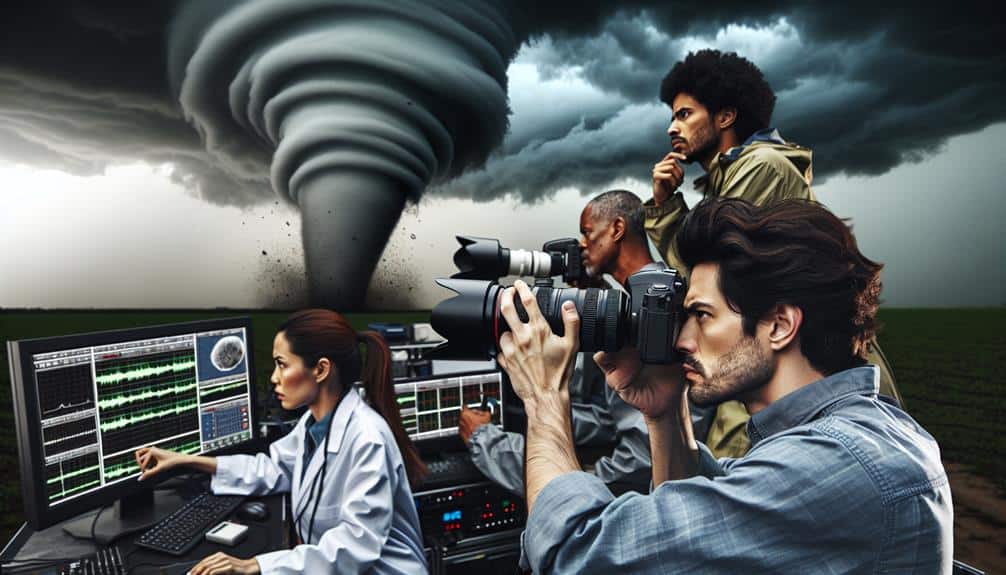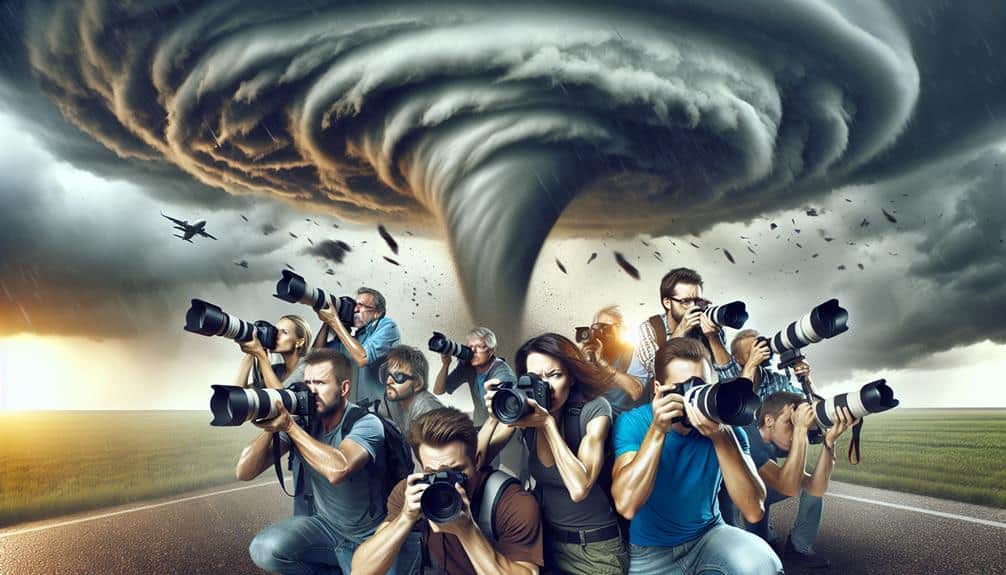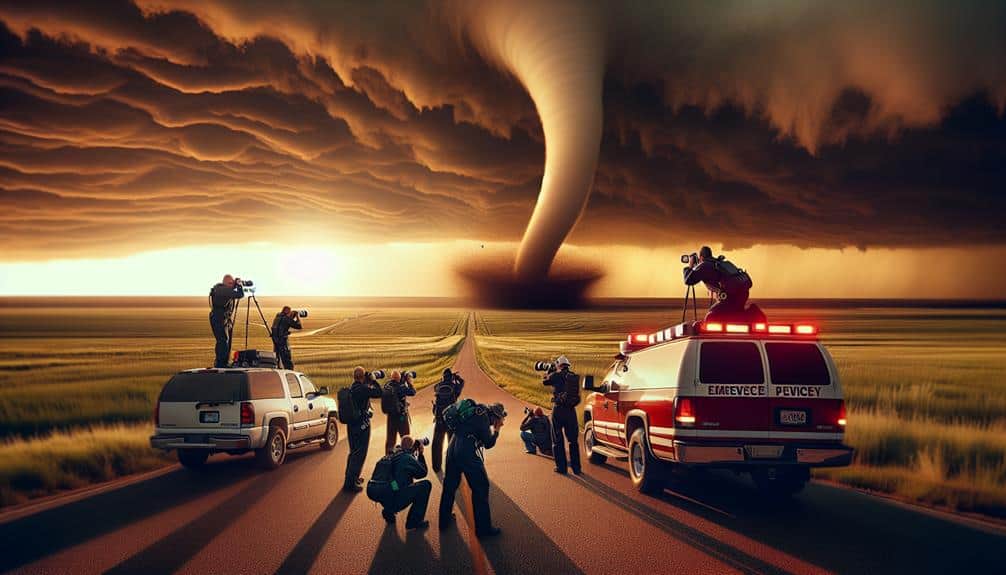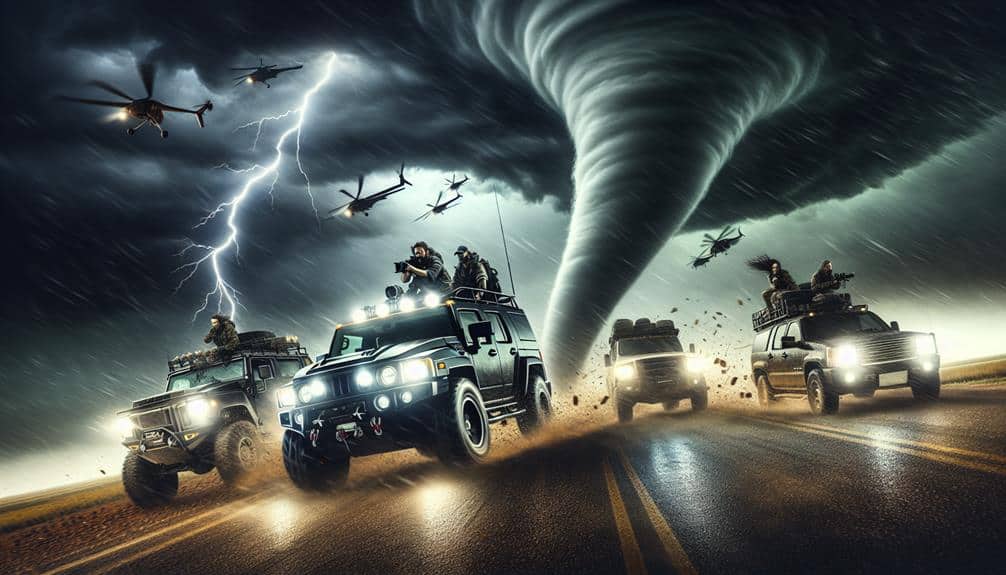We often see storm chaser media coverage fraught with controversies, primarily due to sensationalism and ethical concerns. These reports can distort the reality of weather events by prioritizing dramatic footage over accurate information and potentially compromising safety. The quest for compelling visuals often exaggerates storm intensity, leading to a skewed public perception of risk. Additionally, storm chasers can interfere with emergency responses and violate residents' privacy. Financial motivations can also overshadow the educational purpose of these reports, raising credibility issues. To explore these complexities further, continue here.
Key Points
- Sensationalism in storm chaser media distorts reality and prioritizes dramatic footage over factual reporting.
- Sensationalized coverage creates skewed risk perception, leading the public to underestimate severe weather dangers.
- Storm chasers can inadvertently block roads and hamper emergency response efforts, complicating rescue operations.
- Filming residents without proper consent raises legal and ethical concerns regarding privacy violations.
Sensationalism in Reporting
Sensationalism in storm chaser media coverage often distorts the reality of weather events, prioritizing dramatic footage over factual reporting. When we watch these broadcasts, it's evident that the focus is more on engaging visuals and less on accurate information. This media manipulation exploits viewers' emotions, turning storms into entertainment rather than educational opportunities.
By leaning on exaggerated storytelling, networks aim to boost their ratings, drawing more eyes to their screens. We've seen how this ratings-driven approach can overshadow the importance of delivering precise weather information. Instead of providing the public with the data they need to stay safe, these segments often emphasize the most extreme aspects of the storm. This can lead to a skewed perception of the actual risk involved.
Moreover, the exploitation of weather events for viewership can inadvertently lead to misinformation. When the narrative is crafted to be as compelling as possible, critical details may be overlooked or downplayed. As a result, the audience mightn't receive a thorough understanding of the storm's impact.
It's essential we remain critical of such coverage and seek out reliable sources that prioritize accurate, detailed reporting.
Ethical Concerns
Ethical concerns in storm chaser media coverage arise when the pursuit of dramatic footage compromises safety and integrity. As storm chasers, we've a responsibility to adhere to ethical guidelines that prioritize honest reporting over sensational content.
Media responsibility should guide our actions, making sure we don't exploit viewers by exaggerating the intensity of storms or the risks involved.
When we prioritize sensational content, we risk undermining the trust viewers place in our reports. Ethical guidelines require us to present footage that accurately reflects the storm's nature and impact. Failing to do so not only misleads the public but also fosters unnecessary fear and panic. We must balance the need for compelling visuals with the imperative to inform responsibly.
Viewer exploitation occurs when media outlets prioritize shock value over factual reporting. This approach can desensitize audiences to real dangers and diminish the educational value of storm coverage.
Our goal should be to provide clear, accurate, and useful information, rather than merely attracting clicks or views. By adhering to strong ethical standards, we can make certain that our coverage empowers viewers with knowledge rather than exploiting their emotions for sensational gains.
Risk to Public Safety
When we consider the risk to public safety, storm chaser media can encourage dangerous behavior by glamorizing hazardous situations.
It may also create a misleading perception of risk, causing people to underestimate the dangers posed by severe weather.
Additionally, the presence of storm chasers can interfere with emergency response efforts, potentially putting more lives at risk.
Encouraging Dangerous Behavior
Storm chaser media coverage often encourages dangerous behavior by glamorizing extreme weather conditions and enticing thrill-seekers to take unnecessary risks. By showcasing the adrenaline rush and excitement of confronting nature's fury, these media outlets can inadvertently promote reckless actions.
While the imagery and stories are compelling, we must consider the ethical implications of such portrayals.
Here are four ways storm chaser media coverage encourages dangerous behavior:
- Thrill Seeking: By emphasizing the thrill of chasing storms, media outlets can inspire viewers to seek similar experiences without proper training or understanding of the risks involved.
- Adrenaline Rush: The focus on the adrenaline rush associated with storm chasing can lead individuals to prioritize excitement over safety, putting both themselves and others in harm's way.
- False Sense of Security: Professional storm chasers often have specialized knowledge and equipment. However, viewers might underestimate the dangers, believing they can safely emulate what they see on screen.
- Social Media Encouragement: The desire for social media fame can drive people to engage in hazardous behavior to capture dramatic footage, further perpetuating risky actions.
We must balance the allure of storm chasing with the responsibility to promote safe practices and informed decision-making.
Misleading Risk Perception
Misleading risk perception in storm chaser media coverage can greatly endanger public safety by playing down the inherent dangers of severe weather events. When media outlets sensationalize storm chasing, they often create a skewed risk perception among the public. People may underestimate the severity of tornadoes, hurricanes, and other extreme weather, thinking they're less perilous than they are. This misjudgment can lead to poor decision-making during emergencies.
We must recognize the significant media influence in shaping public attitudes toward weather risks. Sensationalized footage, while enthralling, can inadvertently send the message that severe weather is an intriguing spectacle rather than a serious threat. Viewers might feel emboldened to ignore safety warnings, believing they can witness these events without facing real peril.
As responsible members of society, it's vital for us to demand accurate and balanced reporting. We need media coverage that emphasizes the true risks and encourages appropriate precautionary measures. By fostering a realistic understanding of severe weather, we can help guarantee that individuals make informed decisions to protect themselves and their communities.
Let's work towards a media landscape that prioritizes public safety over sensationalism, reducing the risk perception gap caused by misleading coverage.
Emergency Response Interference
Interfering with emergency response efforts during severe weather events poses significant risks to public safety. As storm chasers navigate dangerous conditions, they can inadvertently block roads, hamper rescue operations, and create confusion. To lessen these risks, we need to discuss how everyone can contribute positively.
First, fostering strong community partnerships is essential. When storm chasers collaborate with local authorities and emergency responders, everyone benefits from shared information and resources.
Second, effective communication strategies are vital. Clear and consistent communication can help guarantee storm chasers don't hinder emergency efforts. This involves:
- Establishing protocols: Guidelines should be in place for storm chasers to follow, ensuring they know when and where their presence is beneficial or harmful.
- Utilizing technology: Apps and real-time data sharing platforms can keep storm chasers informed about emergency zones, roadblocks, and safe areas.
- Training: Providing storm chasers with training on emergency response procedures can help them act responsibly during critical moments.
- Coordination: Regular meetings and briefings between storm chasers, emergency services, and community leaders can promote a collaborative environment.
Privacy Violations
In the pursuit of capturing dramatic footage, storm chasers often face criticism for potentially infringing on the privacy of affected individuals. When storm chasers enter disaster-stricken areas, they sometimes film residents without obtaining proper consent. This raises serious legal implications and consent issues, as individuals mightn't want their personal struggles broadcast for public consumption.
Media ethics come into play when considering the consequences of such invasions. It's crucial to weigh the public's right to know against the individual's right to privacy. By showcasing intimate moments of distress, storm chasers risk exploiting the vulnerabilities of those impacted by severe weather events. This can lead to emotional harm and a sense of violation for the victims.
Moreover, the consequences of invasion can extend beyond personal discomfort. Legal actions could be taken against storm chasers who don't respect privacy laws, potentially leading to fines or other penalties.
To uphold ethical standards, it's vital that storm chasers seek permission and remain sensitive to the context in which they're operating. By doing so, they can balance their mission to inform the public with a respectful approach to those who are suffering.
Impact on Science

We need to take into account how storm chaser media coverage affects scientific research, specifically regarding data accuracy concerns and public perception.
Accurate data collection is essential for understanding and predicting severe weather, but sensationalized coverage can sometimes distort the facts.
Additionally, the way media portrays storm chasers can shape public opinion, potentially influencing support for scientific endeavors.
Data Accuracy Concerns
Although storm chasers provide valuable real-time data, the accuracy of this information often raises concerns within the scientific community. We need to address several key issues to ensure that the data collected by storm chasers can be reliably used for scientific purposes.
One major concern is bias detection. Storm chasers might unintentionally collect data that reflects their own interests or limitations, rather than providing an objective picture of the storm's behavior.
Validation methods are vital in this scenario. Without proper validation, the data's credibility remains in question, which can have a significant impact on scientific research and weather forecasting.
We must consider:
- Inconsistency: Different storm chasers may use varied equipment and methodologies, leading to inconsistent data.
- Subjectivity: Human judgment can introduce subjective biases, especially in chaotic storm environments.
- Lack of Standardization: There's often no uniform protocol for data collection, making it hard to compare across different sources.
- Real-Time Pressures: The urgency to broadcast live updates can compromise the thoroughness and accuracy of data collection.
To uphold the integrity of scientific research, it's essential that we implement rigorous bias detection and validation methods. Only then can we fully harness the benefits of storm chaser data without compromising on accuracy and reliability.
Public Perception Influence
Shaping public perception, storm chaser media coverage can greatly influence the scientific community's reception and interpretation of weather phenomena. When media outlets prioritize sensationalism over accuracy, media bias becomes a significant concern. This bias can skew public opinion, leading individuals to either overestimate or underestimate the risks associated with severe weather events.
As storm chasers, we've a social responsibility to present our findings with integrity. The influence of our coverage extends beyond immediate viewers; it impacts how the broader public perceives weather science. Misleading footage or exaggerated reporting can undermine scientific efforts, causing the public to question legitimate research findings. This skepticism may result in reduced support for funding and policy changes critical to advancing meteorological science.
Moreover, the way we frame our stories can either contribute to or detract from public understanding of climate change and its effects. Accurate, responsible reporting helps build trust between the scientific community and the public. By avoiding sensationalism and focusing on factual representations, we can make certain that our influence fosters a well-informed public opinion.
In turn, this informed perspective supports the ongoing efforts of scientists dedicated to understanding and mitigating severe weather impacts.
Financial Motivations
One of the primary drivers behind storm chaser media coverage is the financial incentives that come from selling dramatic footage to news outlets and entertainment channels. This financial motivation can greatly influence the behavior and decisions of storm chasers. Sponsorship influence can lead to exploitation risks, where the need for engaging content could push chasers into dangerous situations.
It's important to recognize that profit-driven narratives can sometimes overshadow the factual, educational aspect of storm chasing, causing credibility issues.
While financial gain can propel the industry, it also raises ethical concerns. Here are several key points to keep in mind:
- Sponsorship Influence: Sponsors often demand high-impact footage, which might encourage chasers to take unnecessary risks, potentially endangering lives and property.
- Exploitation Risks: The quest for sensational content can lead to the exploitation of severe weather events, where the suffering of affected communities is overshadowed by the 'thrill' of the chase.
- Profit-Driven Narratives: When the primary goal is profit, the integrity of the information presented can be compromised, leading to sensationalism over substance.
- Credibility Issues: Financial motivations can sometimes make it hard to discern genuine educational content from dramatized footage, affecting the public's trust in storm chaser media.
Understanding these financial motivations helps us critically evaluate storm chaser media coverage.
Frequently Asked Questions
How Do Storm Chasers Fund Their Expeditions?
We fund our expeditions through various funding sources, including personal savings, grants, and sponsorship deals. Sponsorship deals often come from companies seeking media exposure. These funding sources help us maintain independence and pursue our passion freely.
What Qualifications Do Storm Chasers Typically Have?
Did you know 80% of storm chasers have a degree in meteorology or related fields? Our educational background and experience guarantee we follow strict safety protocols and responsibilities, keeping us and others safe during extreme weather events.
How Has Technology Changed Storm Chasing Over the Years?
We've seen remarkable changes in storm chasing thanks to drone technology and live streaming capabilities. These advancements allow us to capture real-time data and provide instant updates, enhancing both our safety and the accuracy of our reports.
Are There Any Famous Storm Chasers in Popular Culture?
We've seen famous storm chasers like Reed Timmer from the series *Chasing Twisters* and the *Tornadoes* episode of *Reality TV*. The film *Twister* also made storm chasing iconic in popular culture.
What Kind of Equipment Do Storm Chasers Usually Carry?
We usually carry camera gear and safety equipment to capture and protect ourselves during storms. Communication devices and GPS trackers are essential for staying connected and finding our way safely. This setup guarantees we document events accurately and stay safe.


